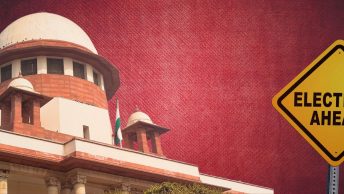This is the second part of the post, where the author traces the contested political identity of India, as manifested in the Constituent Assembly Debates, which oscillated between a Presidential system and a parliamentary system. Part I of the blog can be accessed here.
Section III: The Executive and Legislature: It Takes Two to Tango?
Dr. K.T. Shah was wary of the aforementioned loose separation of powers, which he believed could be used by the executive to corrupt the house by offering gifts and favours to the members. He proposed adoption of the American Presidential Model for a complete separation between the Executive and Legislature to ensure greater transparency and accountability. This proposal found support from members like Shibban Saxena and Syed Karimuddin, who were worried that the unchecked powers of the Executive in a parliamentary system would lead to the suppression of all dissent from the opposition. The numerous minorities in the country, without any representation at the centre, would then become vulnerable to the whims and fancies of the majority party. The upper-caste Hindu composition of the Indian National Congress served as a precedent for this suspicion. Interestingly, B.R. Ambedkar’s argument for the adoption of the modified form of the Parliamentary system which envisaged the legislature and executive as separate entities was also rooted in the prevention of a similar dictatorial executive. India, however, needed a strong executive to carry out significant reforms, as she could not afford to lose any years of development in a tussle between the Legislature and Executive, which was all too common to the American Presidential system. The executive, in his view, was to be strong in order to support the imminent Indian revolution but was to be responsible and answerable to the legislature. Peculiar to the Indian and British political frameworks, elections run on a party system, therefore, there was a deep-rooted belief that the parliamentary form of government would be befitting for India’s political landscape. This would allow India to have a strong executive while ensuring accountability. However, as voiced by Saxena, this belief could also be fallacious and a blind adoption of the British model would be ineffectual due to the absence of the parliamentary conventions and traditions that the British have developed in the past 700 years. Therefore, in this process of negotiation between creating a strong executive to achieve the social revolution while preventing the formation of a dictatorial behemoth, India was never to lose sight of the strong Checks and Balance system that Dr Ambedkar envisaged. It was India’s colonial past which made the social revolution necessary, but the adoption of a strong executive, responsible and answerable to the legislature to carry the revolution forward, was a model uniquely curated by Indians for India.
Section IV: The Checkmate: The Final Subversion of the Constitution
The BJP government took calculated steps to abrogate Article 370 which had come to acquire a permanent status after Sampat Prakash. The first step was a political move by the President: Pulling out of the coalition government which led to its falling and allowed the President’s rule to be imposed in the state under Article 356. The second step was the suspension of the State Assembly by the President, this suspension shifted all the constitutional powers of the Jammu and Kashmir state assembly to the Indian Parliament. Therefore, the Parliament, where the BJP government had the majority seats, assumed the status of the State Assembly under Article 370(3) for the purpose of amendments to the J&K Constitution. However, this was not enough, as there was a requirement of assent by the Sadar-i-Riyasat for any amendment to be passed under Article 370(1)(d). This led us to the third step: The BJP government used Mohammad Maqbool Damhoo to interpret Sadar-i-Riyasat to mean the incumbent governor of the state, who was appointed by the President in consultation with the Council of Ministers. Therefore, the executive’s power in the governor was used to finally pass the amendment required to abrogate Article 370 from the Indian Constitution. The President, The Executive and the Legislature all acted as one unified unit and through deliberate steps were successful in the abrogation. The vision of B.R. Ambedkar which wanted to ensure a distinction between the Legislature and Executive to ensure accountability of the latter came crashing down. This makes one wonder whether the dissent voices in the constituent assembly which consisted mainly of the minority parties were correct in their determination of a dictatorial executive.
Conclusion
In this paper, I have primarily dealt with the question, of whether India’s Executive took shape the way it did due to its post-colonial status. I have tried to analyse the same through understanding the constituent assembly debates and secondary literature which points towards the reasons for the adoption of the modified form of the parliamentary system. This has led me to understand that the formation of the Indian Executive was a result of India’s post-colonial status. However, this formation was a negatively impacted by the formation of the colonial state. This means that the political situation of India was negatively impacted by the British Parliamentary system and in order to ‘fix’ the same adopted the modified parliamentary system. This has been substantiated using Rau and Ambedkar’s vision which justifies this adoption to be a product of India’s political scenario. In order to contextualise this debate, I have tried to compare the vision of the constitution makers with the current political scenario in J&K. This was done to highlight the misuse of the constitutional powers by the government and a complete disregard of the reasons for which the constitutional powers were granted.
Nidhi Agrawal is a third-year student at National Law School of India University, Bangalore.
[Ed Note: This article has been edited by Utkarsh Mani Tripathi and published by Harshitha Adari from the Student Editorial Team]







[…] Posted byNidhi Agrawal […]